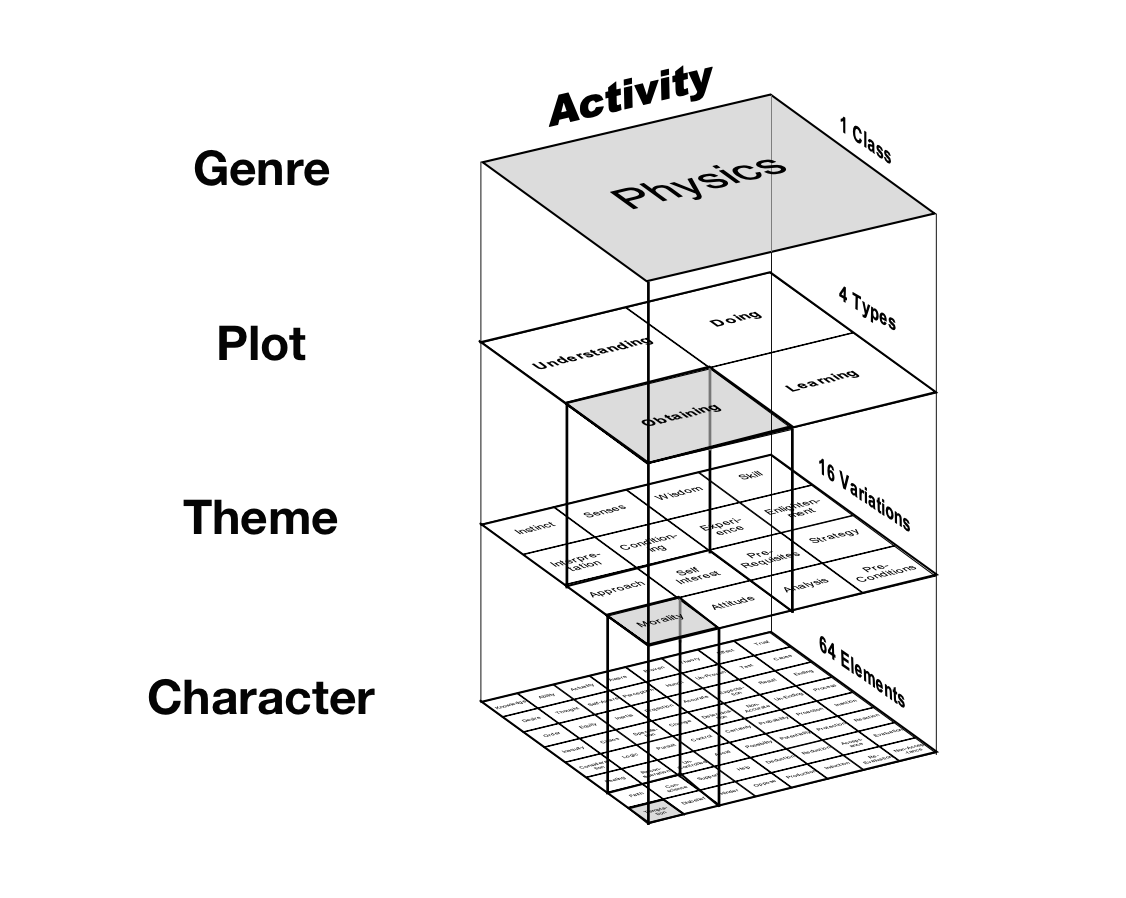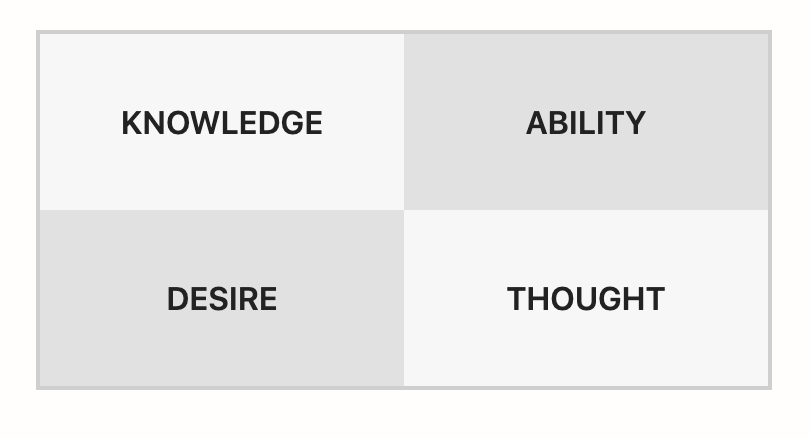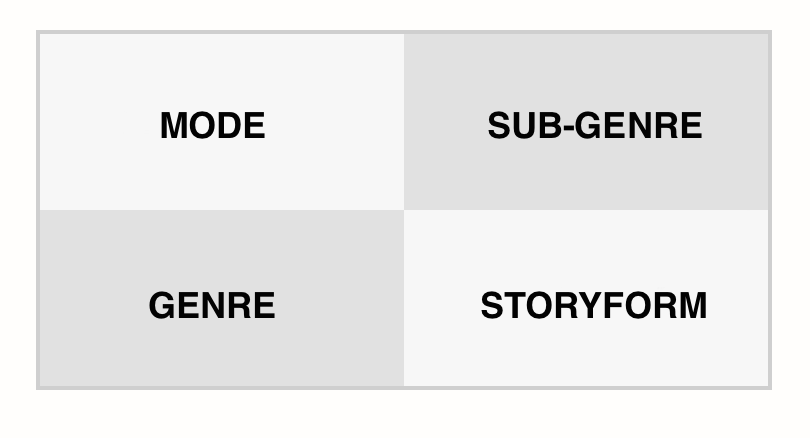The Development of Genres and Sub-Genres
Classifying the personality of a story
Genres and Sub-genres were an exciting development this year. They began as a simple way of checking trends across multiple storyforms. Starting, they were known only as Genres, but the act of categorizing some 450+ storyforms revealed the need to split them out into Genres and Sub-genres. Once validated as revealing key insights, Genres found its way into the upcoming Premise Builder.
Their most significant influence, however, wouldn’t be felt until several months later—and only then as a chance discussion about an elf in New York City.
The Structure of Genre
The Dramatica theory of story finds narrative structure across four levels of resolution. Starting with the most general, and working its way to the very specific, the model identifies a cascading relationship falling from Genre to Plot to Theme to Character.

Genre incorporates everything below as it determines the overall personality of a story. A narrative that explores both objective and subjective concerns of external conflict is a much different kind of story to hang out with than one where both focus on the internal.
The juxtaposition of both Main Character and Objective Story Throughlines, along with a tinge of Plot-level concerns, generates a unique identity. This ID signals to the Audience an expectation of experience—an experience born of meaning, not setting.
You don’t go to a Marvel movie expecting a memory play. You don’t read Shakespeare anticipating action and adventure. You visit the former for explorations of external conflict resolution, and you sample the latter for insight into the psychologies and mindsets of those in conflict. Of course, you can always break Trends—which I’ll get into in a moment—but the Genre of a story is an overall tell for the Audience.
And a great way to quickly determine the narrative structure of a story.
Framing a Narrative
Genre sits at the top and is the most genre-al. Character lies at the bottom, detailing specific Elements of motivation.
It was only during an analysis of the Holiday Classic Elf, that I finally realized those two levels are all you need to frame narrative structure accurately.
For years I tried to find the storyform for Elf, and for years I always came up short. With the new Personality model in Subtxt, it took me all of three seconds to put it together.
Elf is a light Holiday Comedy. Holiday Comedies juxtapose a Main Character Throughline in Universe with an Objective Story Throughline in Psychology.
Top level set.
The opening sequence tells us a “holiday spirit crisis” exists. Copying the driving character Elements of Cause and Effect from Monsters, Inc., Elf fuels its narrative drive with an energy shortage.
Bottom level set.
And the narrative structure of the film determined.
::premise Being truthful magnifies your higher state of vibration, allowing you to address your innate capacity to bring good cheer with others. ::
Imagine being able to do that with your story?
That’s the whole point of Subtxt. And the reason why these advancements in Genre and Sub-genre were so significant this year.
Greater Definition of the Genre-al
I coin the method used with Elf the Genre-al approach to finding the unique narrative structure of a story. By starting with Genre and looking first for the general areas and relationships of conflict, one can quickly zero in on the exact storyform with high precision.
But if we’re looking for a more general understanding of narrative, why is it not enough to simply categorize a film like Raiders of the Lost Ark an Action film? Why the need to modify it with the Adventure moniker? And how is an Action/Adventure different from a Family Adventure?
Answers to these questions led to the development of Sub-genres—and the discovery of a Personality Quad present within the Dramatica model.
The Quad is the scaffolding of Dramatica. Every concept within the model exists as an extraction of four base Elements arranged into a quad: Knowledge, Thought, Ability, and Desire. The arrangement of these four into a grid communicates the essential qualities of their natures.

With Knowledge in the upper left-hand corner, Knowledge and Thought appear as separate states. You’re either thinking about something or going off of knowledge—but never both at the same time. Abilities and Desires then become more of a sliding scale. In contrast to the static state of Knowledge and Thought, Ability and Desire appear as processes.
Grafting the personality of a story into this Quad reveals the reason for a Sub-genre component.
If the storyform is a static element of personality, then Genre must exist along that sliding scale axis of Ability and Desire. Genre must then consist of two parts: Genre and Sub-genre. While neither Ability nor Desire is a subset of the other, the Sub-genre nomenclature works well as an easy identifier of its relationship to Genre.
The Base Elements of a Narrative Personality
The storyform, specifically, is an area of Thought—it’s what that person wants another to think. It represents the energetic transfer of consciousness from one individual to the next.
Working backward, Genre expresses the temporal experience of Desire. Thrillers strike the subconscious different than Comedies or Adventures. The development of living with that personality over time defines the Genre of the piece.
Sliding into Ability, the Sub-genre reveals a trend of spatial organization within a personality. The communication capabilities of an Action Thriller strike a different chord than those of a Psychological Thriller. Their resonance defines a trend more akin to purpose than to thought.
These three Elements set into a quad creates a vacuum--a fourth Element must complete the set. It wasn’t until I began to incorporate Personality into Subtxts codebase that I began to understand why.
The Modality of Genre
What does it mean to label Elf a light Holiday Comedy? How is that different from a heavy Holiday Comedy?
Light narratives emphasize Comedy and Entertainment. Heavy ones use Drama and Information to convey their message.
Elf and Home Alone are both Holiday Comedies. While they both exhibit a certain amount of Entertainment, Elf trends toward Comedy while Home Alone appears quite Dramatic in places. The result is a difference in how the two films structure their narratives:
The light Holiday Comedies find the Objective Story and Main Character Throughlines in a vertical alignment. The dramatic Holiday Comedies find the two in a horizontal arrangement.
Light and dark are Modes of Genre. Big chunky dials with only four settings. They work together with Sub-genre as a Companion Pair assigned with the responsibility of setting the arrangement of a personality’s narrative structure.
A Visual Representation of Personality
With this final Element of Genre set into place, the Quad of Personality is complete:

Think of the path through the Quad as moving from the grossly general to the finely-tuned specific. Mode to Sub-genre to Genre to Storyform. A vague notion of intent that leads into a fully-formed purpose.
2020 will see further development into this area, including an investigation into the practical application of light and heavy as indicators of Mode, and the exploration of meaningful relationships between the Elements of Genre.
Download the FREE e-book Never Trust a Hero
Don't miss out on the latest in narrative theory and storytelling with artificial intelligence. Subscribe to the Narrative First newsletter below and receive a link to download the 20-page e-book, Never Trust a Hero.

